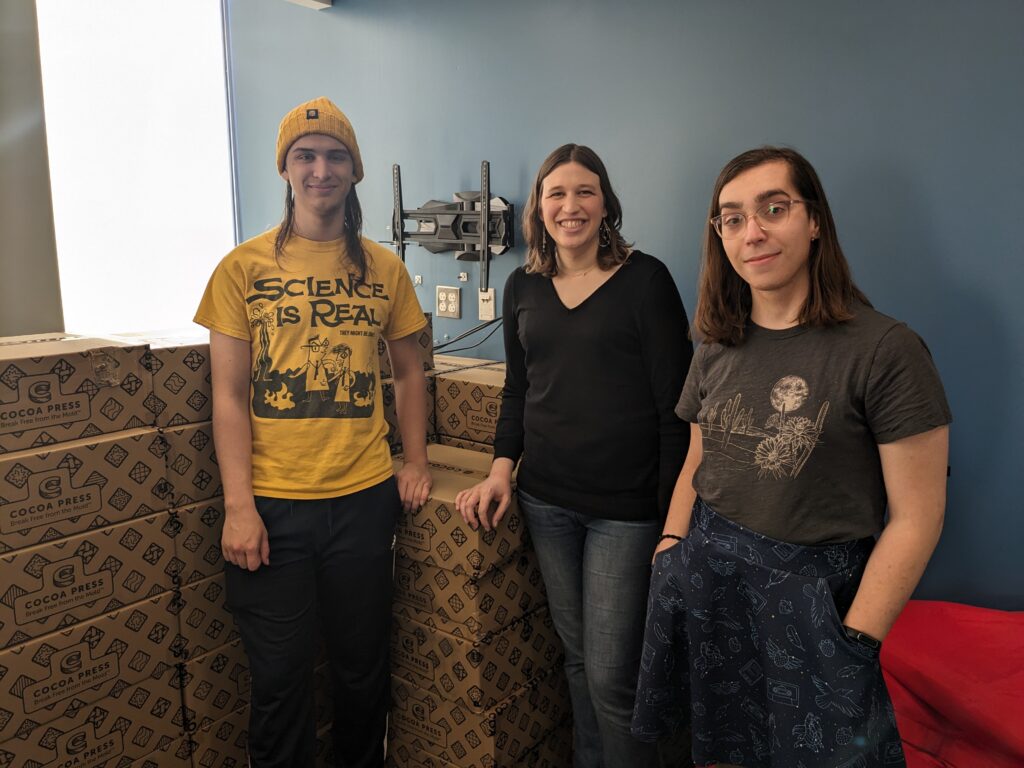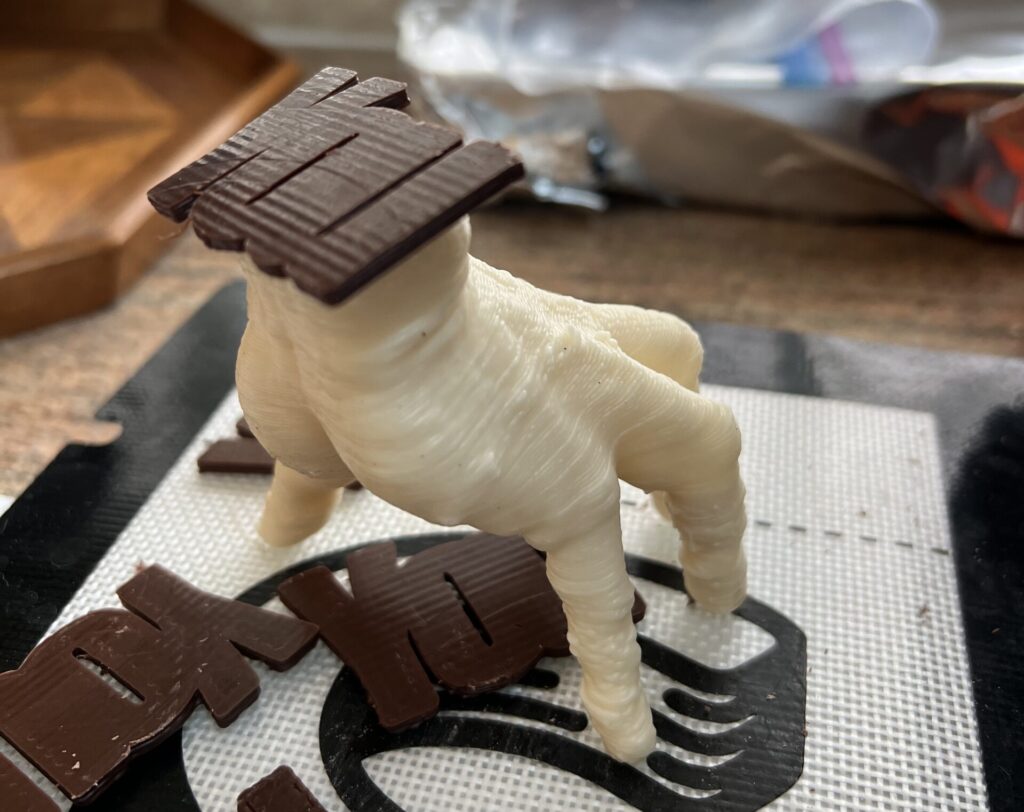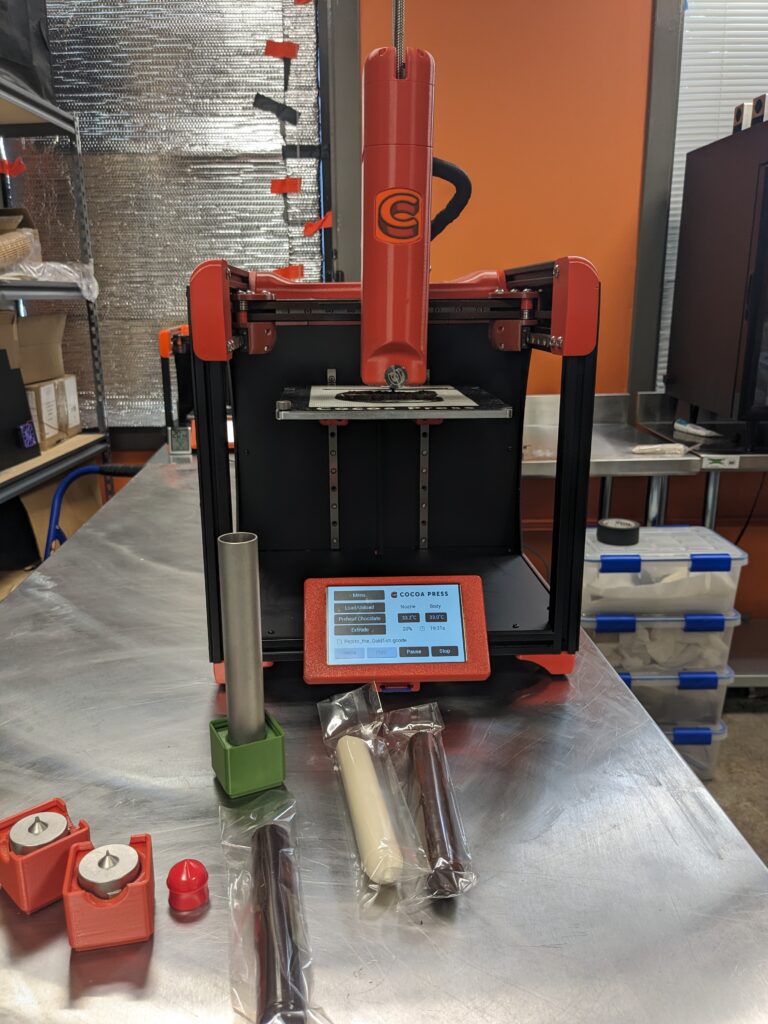It was just supposed to be a one-semester engineering project. A chocolate 3D printer? A fun thought experiment, perhaps even a tasty one, but no one would seriously build that, right?
Every maker has that one idea that captures their imagination and for Ellie Rose, that project was the Cocoa Press. A fusion of unwavering culinary engineering, the RepRap movement’s DIY spirit and an undeniable dash of Philly stubbornness, paved the way for the ten-year journey that now sees this machine slowly popping up on desktops around the world.
2024 still had that new car smell on it when I was given the chance to spend a day with Rose and a few members of her team at the Cocoa Press workshop. Tucked away in a quiet corner of Philadelphia, I entered a workspace where the air was buzzing with the gentle thrum of Prusas—each loaded up with a spool of custom-made PETG filament printing away the parts that would soon adorn some lucky maker’s future Cocoa Press.
 From left to right: River, Ellie and Kim
From left to right: River, Ellie and KimOur conversation was pretty wide-ranging. We talked about everything from internet drama to BattleBots (Ellie recently joined a team), but the question burning a hole in my notebook was the most obvious one: Why did she keep this up? The Internet is littered with 3D printing projects that withered on the vine, if they ever truly germinated in the first place. As sad as it was to consider, at the same moment Rose was turning over the question, someone, somewhere, likely had dreamt up a million-dollar idea that they would probably abandon by the end of the day.
“I guess I’m just a little bit obsessed.” Everyone in the room laughed when she said it, but there was a real seriousness hanging on her words. “Anything I learned in engineering classes; it all went back into the printer.” Ellie wasn’t afraid to describe the fallow periods where an earlier version of the printer sat unchanged for weeks or months until the lightbulb went off for the next revision. The Cocoa Press workshop itself was a kind of living history of food 3D printing. The earlier versions of the printer were proudly displayed on shelves, and Rose lit up when she got the chance to show off her MakerBot Cupcake.
Ellie blushed at the suggestion that she’d end up as an early chapter in some eventual book about 3D printed food. She and the Cocoa Press were already featured in the most recent volume of 3D Printing for Dummies, in its section on food 3D printing. After a bit of prodding from her team, she admitted she’s been asked to give a keynote at a food 3D printing conference.
Specs of the Cocoa Press
So, let’s talk about the Cocoa Press itself.
This printer lacks some of the things you’d expect to find on the usual DIY 3D printer builds. There is no Z endstop, because there’s no real risk of the tool head colliding with the bed. The bed isn’t heated and there’s no fan—ambient room temperature matters quite a bit for getting successful prints. Too warm and you’re looking at a runny, but delicious chocolate mess.
The device comes stock with a .08mm nozzle and an additional 1.6mm nozzle, a cartridge body that houses 65 gram chocolate cores, and a silicon baking mat for a print surface. Overall, it has a desktop profile a bit smaller than an Ender 3. It definitely looks like it would be more at home on a countertop next to a KitchenAid than it would in a workshop with other printers.
The Secret Ingredient
We’ve also got to talk about the chocolate. Yes, it was delicious. I was encouraged to take as many photos as I liked during my day in the lab, but was asked not to capture pictures of any chocolate bags. Finding the right mix of chocolate for the device seems to have been one of the more challenging aspects of its development. Despite some grumbling online that Cocoa Press hasn’t adopted a more open-source ethos in regards to its chocolate recipe, you get the sense that the team would welcome other makers attempting to craft their own perfect cores.
“Over the years a lot of people have made suggestions about the printer’s design—how it runs. Now, some of those people have them and I’m getting messages like ‘Oh, I get why that idea was totally wrong.’” Rose’s voice dripped with joy as she recounted this. There’s a victory in this printer going wide. It’s not just overcoming the engineering or production challenges. Now, every single person building and printing on a Cocoa Press is going to have to live with the ideas that have been consuming her and her team.
One thing that was impossible to ignore was how freely and quickly ideas flew around the Cocoa Press workshop. When someone made an off-hand comment about printing ice sculptures, there was a serious conversation about attempting to pop a Cocoa Press in a chest freezer. As a natural instigator, it took an incredible amount of restraint not to encourage them as the team gradually talked themselves out of it.
According to the Cocoa Press group, the largest categories of buyers appeared to be 3D printing enthusiasts, followed by small businesses and schools. While earlier versions of the machine were designed with small businesses in mind, the model that’s gone wide is built for the hobbyist space and Cocoa Press feels comfortable operating in that lane for now.
Who Buys a Cocoa Press?
Still, I was curious about who was building these printers. Also, it almost seems silly to ask, but a lot of people might wonder, why chocolate? The precise heating and extrusion of a foodstuff most certainly has other applications – we’ve already seen attempts at frosting & icing printers, as well as a pancake printer. But it takes a particular mind to see the unique properties of chocolate as a selling point rather than a gimmick. I reached out to maker DaveMakesStuff about his Cocoa Press experience and was surprised that he had just one of those minds:
“A lot of my designs are intended for ‘spiralized’ printing…’Spiralize’” printing is a really good way to print with a material like chocolate because you don’t need to worry about retractions, your model is printed in one long smooth chocolate extrusion! The first time I saw a video of the Cocoa Press I started to get design ideas that I wanted to try.”
In a lot of ways, Dave’s reaction to the Cocoa Press affirmed many of the things Ellie said to me regarding the printer’s development.
“I knew this was the right direction when I saw the most crowded section at the Times Square M&M store was where people could personalize their own candy.”
In this age where almost any product imaginable is only a few clicks away, how do you make your product stand out? The customization. Anyone can bring their sweetheart a box of chocolates, but printing those chocolates yourself? Or giving them a cupcake with a custom chocolate topper? That’ll make an impact.

“I have a Thing for You” – Valentine’s Day print designed by Philly Wonka, an avid contributor to the Cocoa Press discord.
Speaking of customization, the option to print your own parts has lead to some fantastic looking builds, like YouTuber Zack Freedman’s novel printer. DaveMakesStuff also opted to print his own pieces and overall found the process of putting together his machine fairly straightforward.
“Assembly of the printer definitely requires some knowledge and experience working with 3D printers, but the manual is clear and well laid out. The Cocoa Press support team is also super helpful,” Dave told me.
During my time spent at the Cocoa Press lab, I found myself equally impressed with the startup’s assembly instructions. It is by far one of the clearest product build manuals I’ve ever encountered. The team took a lot of pride in its focus on user experience and you can see that work reflected back in the passionate community growing around this printer.
What’s Next for Chocolate 3D Printing?
When Dave told me he’s working on tuning his Cocoa Press’ settings to hopefully produce water-tight chocolate shot glasses, I couldn’t help but wonder what other fantastic treats we might see in the next few months. The number of YouTube and Reddit comments I’ve seen about whether or not certain psychoactive ingredients can be used in conjunction with the system leads me to believe we’ll definitely seem some interesting content from that genre sooner rather than later.
On the day I visited the site, 130 printers had been boxed up and mailed out to makers with #131 getting prepped for shipping. The ever-increasing activity in the Cocoa Press Discord and videos posted on TikTok & Reddit reveal a still growing community of makers getting more and more comfortable showing off their chocolate prints.
Rose and the team have a lot of hopes for the future of the Cocoa Press. They tell me they’d like to potentially create different tool heads and work on their ability to serve customers like bakeries, but an educational series related to the printer is probably coming down the pipeline first. Right now, their main goal is just to “help people make cool stuff.”
There’s just one question left before I end my day at Cocoa Press: They’ve printed chocolate, why not another food?
“Butter,” Ellie said without missing a beat. And I could see the wheels start turning.
Subscribe to Our Email Newsletter
Stay up-to-date on all the latest news from the 3D printing industry and receive information and offers from third party vendors.
You May Also Like
Further Understanding of 3D Printing Design at ADDITIV Design World
ADDITIV is back once again! This time, the virtual platform for additive manufacturing will be holding the first-ever edition of ADDITIV Design World on May 23rd from 9:00 AM –...
3D Printer Maker EVO-tech Reborn as NEVO3D — Once More With Feeling
EVO-tech was a 3D printing service and original equipment manufacturer established in 2013 and based in Schörfling am Attersee, Austria. The company produced high-quality material extrusion systems featuring linear bearings,...
3D Systems Brings 3D Printed PEEK Cranial Implant to the U.S. with FDA Clearance
For more than 10 years, 3D Systems (NYSE:DDD) has worked hand-in-hand with surgeons to plan over 150,000 patient-specific cases, and develop more than two million instruments and implants from its...
CDFAM Returns to Berlin for Second Annual Symposium
The second CDFAM Computational Design Symposium is scheduled for May 7-8, 2024, in Berlin, and will convene leading experts in computational design across all scales. Building upon the first event...


































